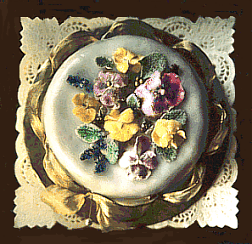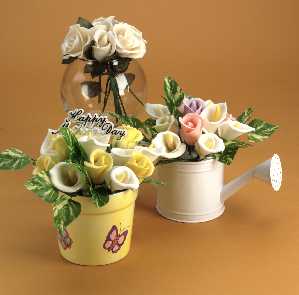|
Edible Flowers
PLEASE, DO EAT THE MARIGOLDS!

Now is the time to try
edible flowers
Yes, you heard it right -- edible
flowers. You're probably thinking that you shouldn't eat
flowers! It's weird! Your human wouldn't let the dog eat
them, so why would you? Not only are flowers pretty to look
at and smell, but some of them taste good, too.
Wait, wait -- don't start
munching on all the flowers in your neighbor's garden quite
yet. Edible flowers aren't found in most flower beds, nor at
the florist shop. Well, you've probably already eaten some
type of flower and didn't even realize it. Broccoli,
cauliflower and artichokes are flowers. Paella and some
risotto dishes use saffron to get that lovely golden color.
Saffron is the stigma of the crocus flower. Capers are the
unopened flower bud of a bush native to the Mediterranean
and parts of Asia. Carnation petals are one of the secret
ingredients that has been used to make the French liqueur,
Chartreuse, since the 17th century. Have any of you ever
eaten the square, violet flavored candies?
You'll find edible flowers at your
local farmer's market or gourmet grocery store. The major
difference between edible flowers and your meowmies regular
spring bouquet is that the edible ones are either
organically grown or treated with organic pesticides like
those used on fruits and vegetables. In addition to those
differences, there are safe and unsafe flowers (just like
there are safe and unsafe mushrooms).
Flowers have been used to flavor
and garnish dishes since ancient times. Many have antiseptic
and medicinal uses as well. Upscale restaurant chefs
commonly use edible petals as a final touch to many salads
and soups. Pastry chefs, especially those who make special
occasion cakes, use crystalized, candied and fresh flowers
to add a touch of nostalgia to their creations.
In Italy and France, zucchini
flowers are often stuffed (commonly with cheese) and then
battered and fried. The blossoms are chopped, sauteed and
served in warm tortillas in Mexico.
When selecting flowers to use with
or on foods, several important guidelines should be
followed: Use only edible flowers, such as the one described
below. Make sure the flowers have been grown without the
help of pesticides or chemical sprays. Flowers from most
florists are treated, so choose those grown specifically to
be eaten or from an untreated home garden. Any flower that
comes into contact with food (such as for a garnish) should
be suitable for human consumptions. All of the flowers
mentioned here are non-toxic and safe for culinary purposes.
Flowers should be picked early in the day and in dry
weather. Rinse them quickly under gently running, cool
water. Blossoms wilt quickly, so only pick what you will use
in one day. Before using, remove the pistils, stamens (the
middle parts) and the white part at the base of the petal.
This white part is called the "heel" and will impart a
bitter taste. If using in a salad with dressing, add the
flowers last. Do not toss with the salad, as the acid in the
dressing will spoil the color and fresh appearance of the
delicate petals. It is best to toss the greens with the
dressing, put a portion on each serving plate and then
sprinkle the petals on.
Basil:There are 150
varieties of this plant with names like cinnamon, lemon and
licorice, depending on the aroma, and the color can range
from green to purple. The flowers as well as the leaves are
edible.
Begonia: the stems of this
flower can be substituted for rhubarb.
Carnation:steep in wine,
make candy or use as a cake decoration. Remove petals from
calyx and snip off the bitter white base before
using.
Chives: both the stem and
the flowers are edible.
Chrysanthemum:the colors
vary from bright yellow to deep rust and the flavor can be
mild or bitter. Taste before using. Briefly blanch before
adding to Chinese-style stir fries or tossing with salad
greens.
Citrus:all forms of citrus
have been cultivated in the Mediterranean and North Africa.
The petals tend to be waxy and have a pronounced flavor, so
use sparingly. Orange flower water is sold in baking supply
and Middle Eastern stores, usually in a blue
bottle.
Cornflower: also called
bachelor's button, this azure colored flower is a natural
food dye. It is used as a garnish and the Germans use it in
a popular liqueur.
Dandelion: is a hardy weed
which is used either raw or cooked. As a child, I often saw
older, Italian-American women in the grassy areas along the
Bronx River Parkway in NYC picking these flowers to use for
dandelion wine. The roots are also used as a coffee
substitute.
Daylily: these flowers live
for only 24 hours. Other varieties are edible, but some are
poisonous, so check with a reference source before using. It
has a crunchy texture and the dried Tiger Lily buds are
added to soups and stir fries in China. Chop or slice and
sprinkle sparingly on salads, soups and omelets.
Dill: The tiny yellow blooms
are a good seasoning for soups or dips.
Gardenia: the light, cream colored
blossom is good for garnish. In the Far East, dried blossoms
are used in jasmine tea which is served in many Chinese
restaurants in the US.
Gladiola: can be used to top
cakes or for garnish.
Hibiscus:the state flower of
Hawaii is also common in the Mediterranean, Mexico, the
Caribbean, Africa and parts of Asia. The fleshy dried calyx
is boiled to make a garnet colored beverage which is
sweetened and served on ice in Mexico and the Caribbean. The
slightly acidic petals can be sparingly added to salads or
lightly cooked. Can also be used as a "container" for diced
fruit (like a cornucopia with the fruit spilling onto the
plate).
Honeysuckle: The white or
pale yellow flowers have a syrupy-sweet nectar. The flowers
can be candied whole or used in sorbets, soft drinks or for
cake decorations.
Lavendar: is used
medicinally as an expectorant and antispasmodic.
Violet: candies are sold in
the US. The dried flowers are used to prepare fragrant
waters, vinegars, custards, sorbets, cookies and the candied
flowers are used to decorate cakes.
Sweet Marigold: Also called
Spanish, Mexican or winter tarragon. The leaves and yellow
flowers have a taste similar to French tarragon. Use
sparingly in herb vinegars, dressings or dishes which call
for tarragon.
Nasturtium: This flower has
a pepper scent and the colorful red, yellow and orange
petals can be tossed in a salad. The whole blossoms can be
stuffed with a sweet or savory mousse or the petals shredded
and added to risotto or mixed with olive oil to top hot
pasta. The leaves have a similar taste to watercress.
Passionflower: is used as a
garnish. The 10 petals are said to symbolize the Apostles
present at the Crucifixion, the 3 styles represent the
hammers used to drive the nails piercing Christ's hands and
feet and the five anthers represent the wounds he suffered.
Rose:The fruit of the rose
(the hip) is a popular Vitamin C laden ingredient in many
herbal teas. Rose water and rose syrup are used extensively
in Middle Eastern and Indian pastries and confections.
Sage: The blossoms have a
less pronounced flavor than the leaves. Do not use wild
sage, which has an extremely strong taste.
Society Garlic: Frequently
used in gardens as a border plant, its mauve starlike
blossoms can be used in any dish which calls for garlic or
tossed in salads. It must be kept in a well ventilated area
due to the overpowering scent. This strong scent makes it
ideal as a natural insect repellant.
Sunflower: if left unopened,
the buds can be steamed or boiled like artichokes and then
tossed with a vinaigrette dressing or butter. The raw petals
have a slightly bitter taste.
Thyme: There are varous
varieties such as lemon and pineapple. The blue flowers add
a distinctive scent to soups and stews.
Tulip: During WW II, much of
the Dutch population survived by eating boiled tulip bulbs!
The blossoms can be used as edible cups for sorbets, sweet
or savorymousses or minced vegetables. White, peach or pink
blooms look great stuffed with a chocolate mousse.
Yucca: the heart of the stem
can be boiled or steamed like asparagus and the crunchy
petals eaten raw, parboiled or stir-fried. Separate the
petals from the bitter center parts.
Here's a short list of
edible flowers and their flavors:
|
Bean Blossoms
|
a sweet, beany flavor
|
|
Borage
|
cool cucumber taste
|
|
Butterblossom Summer
Squash
|
mild flavor
|
|
Chrysanthemums
|
aromatic, pungent flavor
|
|
Dandelions
|
slightly bitter, hint of
mushroom
|
|
Johnny-Jump-Ups
|
mild wintergreen flavor
|
|
Marigolds
|
citrusy flavor, pleasantly
bitter
|
|
Nasturtiums
|
peppery flavor
|
|
Violets
|
subtle, delicate flavor
|
|
Roses
|
take on the taste of
whatever they're mixed with
|
The flowers and buds on common
herbs such as basil, chive, sage, rosemary, and thyme are
also edible.
So Lets make some food with the
edible flowers, decorate a cake, send a recipe or a picture,
show us what can be done with edible flowers

From
our Members

SassyJazmine

I chose this cupcake with candied
flower petals, it just looks so yummy.
and here is a carrot soup recipe
that I found
Holiday Cream of
Carrot Soup
2 tablespoons butter
1 large onion, chopped (about 1
cup)
11/2 pounds carrots, peeled and cut
into 1/4-inch thick rounds (about 4 cups)
1/4 pound potatoes, peeled and cut
into 1/4-inch thick rounds (about 1/3 cup)
4 cups chicken broth
1 cup water
1 bay leaf
Salt and freshly ground black
pepper to taste
1 cup heavy cream
1/8 teaspoon freshly ground
nutmeg
Pinch of cayenne
Nasturtium petals as
garnish
Heat butter in large saucepan, add
onion and cook until soft, stirring often. Add carrots,
potatoes, broth, water, bay leaf, salt and pepper. Bring to
a boil, stir and simmer 20 minutes.
Strain solids and discard bay leaf,
reserving liquid. Add solids to food processor or food mill
and blend to make a fine puree. Gradually add strained
liquid.
Pour mixture into saucepan and add
cream, nutmeg and cayenne. Sprinkle nasturtium petals just
before serving.
Soup may be reheated or chilled and
served hot or cold. Serves 4.
Per serving: 384 calories; 29.3 g
fat (17.6 g saturated fat; 69 percent calories from fat);
27.5 g carbohydrates; 108 mg cholesterol; 836 mg sodium; 6.1
g protein; 6.3 g fiber.

Lloyd

These look good enough to
eat!!!!
Lloyd also sent two addresses for you to
go learn more about edible flowers
Meadowsweets
Elize
Chocolates

Sammy Brewer
Fried Squash Blossoms
1/2 cup all purpose flour
1/2 teaspoon baking powder
1/4 teaspoon garlic salt
1/4 teaspoon ground cumin
1 egg
1/2 cup milk
1 tablespoon vegetable oil
additional oil for frying
12 large freshly picked squash blossoms
Mix first four ingredients in bowl, in another bowl mix
egg, milk and oil. Add dry mixture to egg mixture. Stir
until smooth. Heat oil to 375 degrees F. Dip blossom in
batter and fry. Drain on paper towel.
These are really yummy. Meowmie and I grow squash just
to eat some of the blossoms.
Next
Page
|